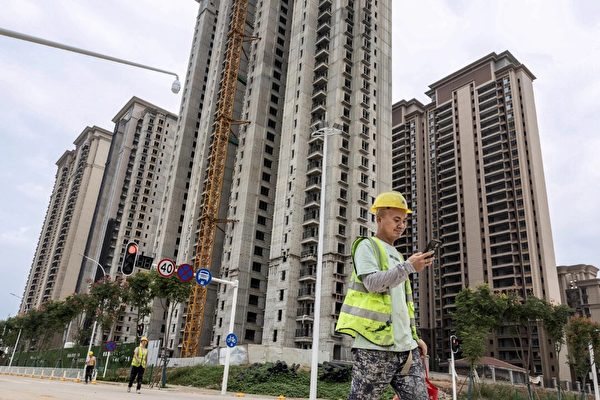The Chinese real estate market continues to experience a simultaneous decline in both quantity and price. According to the latest data, in April, the selling prices of newly built and second-hand residential properties in 70 major cities in China have seen accelerated decreases in both month-on-month and year-on-year comparisons. Foreign media reports indicate that the month-on-month decline in new house prices in April has reached a new high in the past 9 years.
On May 17, the National Bureau of Statistics of the Communist Party of China released data showing that in April, the selling prices of newly built and second-hand residential properties in 70 major cities dropped by 0.6% and 0.9% respectively compared to the previous month, with the declines expanding by 0.3 and 0.4 percentage points, marking near-term highs in month-on-month declines.
However, official Communist Party data often conceals unfavorable circumstances, suggesting that the actual situation could be even worse.
According to Reuters, new house prices in April have seen a month-on-month decline for the tenth consecutive month, with a decrease of 0.6%, marking the largest drop since November 2014.
Data released by the National Bureau of Statistics of the Communist Party of China indicates that new house sales prices continue to fall in key cities, with both year-on-year and month-on-month declines expanding, most significantly in first-tier cities.
Looking at the month-on-month comparison, in April, the selling prices of new homes in first-tier cities decreased by 0.6%, showing an increase in decline by 0.5% compared to the previous month; among them, Beijing, Guangzhou, and Shenzhen saw drops of 0.7%, 1.3%, and 1.0% respectively, while Shanghai saw a rise of 0.3%. Second and third-tier city new house prices fell by 0.5% and 0.6% respectively compared to the previous month, with declines expanding by 0.2%.
Among the 70 cities, only 6 cities saw an increase in new house prices compared to the previous month, a decrease of 5 cities from the previous month. The remaining 64 cities experienced price declines, accounting for approximately 91%.
Looking at year-on-year comparisons, new house prices in first-tier cities in April dropped by 2.5%, showing an increase in decline by 1.0% compared to the previous month; of these, Beijing, Guangzhou, and Shenzhen experienced drops of 0.5%, 6.9%, and 6.7% respectively, while Shanghai saw a rise of 4.2%. Second and third-tier city new house sales prices dropped by 2.9% and 4.2% respectively, with declines expanding by 0.9% and 0.8% from the previous month.
Senior analyst Guan Rongxue from the Zhuge Data Research Center pointed out that the downward pressure on new house prices in April has increased further, with the overall month-on-month decline in prices ending a three-month narrowing trend and exhibiting an expanding trend. Also, the number of cities recording price increases has significantly decreased to a historic low. Overall, the price market seems to be in a continuing slump, without signs of bottoming out.
According to National Bureau of Statistics data, the year-on-year and month-on-month declines in the selling prices of second-hand houses in various cities have expanded, with the greatest downward pressure seen in first-tier cities.
In the month-on-month comparison, second-hand house prices in first-tier cities saw a 1.1% decrease, with a 0.4% increase in decline compared to the previous month. Among them, Beijing, Shanghai, Guangzhou, and Shenzhen experienced drops of 1.6%, 0.8%, 1.4%, and 0.7% respectively. Second and third-tier city second-hand house prices both saw a 0.9% decrease month-on-month, with a 0.4% increase in decline compared to the previous month.
Among the 70 cities, Kunming was the only city where second-hand house prices increased on a month-on-month basis, while the other 69 cities experienced declines.
In year-on-year comparisons, second-hand house prices in first-tier cities dropped by 8.5%, with an increase in decline by 1.2% compared to the previous month. Among these cities, Beijing, Shanghai, Guangzhou, and Shenzhen recorded drops of 8.0%, 7.5%, 10.2%, and 8.5% respectively. Second and third-tier city second-hand house prices dropped by 6.8% and 6.6% respectively year-on-year, with declines expanding by 0.9% compared to the previous month.
Guan Rongxue highlighted that the overall decline in prices among the 70 cities has accelerated, with the number of cities experiencing drops dominating the market, which indicates that it is still in the bottom stage. In addition, looking at the proportion of cities experiencing declines and the overall decline in prices, the downward pressure on second-hand house prices continues to be greater than that for new houses.
According to National Bureau of Statistics data, from January to April, the sales area of newly built commercial housing was 2.93 billion square meters, a 20.2% year-on-year decrease, with residential sales areas dropping by 23.8%. The sales volume of newly built commercial housing was 2.81 trillion yuan, a 28.3% decrease year-on-year, with residential sales volume dropping by 31.1%. Breaking down the data for April, the national sales area of commercial housing was 0.66 billion square meters, a 14.4% year-on-year decrease.
On the supply side of commercial housing, real estate development investment continues to decline. According to National Bureau of Statistics data, from January to April, the total investment in real estate development across the country was 3.09 trillion yuan, a 9.8% decrease year-on-year, with residential investment declining by 10.5%.
Meanwhile, over the past two years, the nationwide inventory of commercial housing has been steadily increasing. By the end of April, the inventory of commercial housing was 746 million square meters, a 15.7% year-on-year increase, with residential inventory growing by 24.5%.
According to Caixin’s information, since 2022, the national inventory of commercial housing has significantly risen. As of February that year, the national inventory of commercial housing was 570 million square meters, and by April this year, it had increased to 746 million square meters. In the past few years, the monthly national inventory of commercial housing has fluctuated between approximately 400 million square meters and 700 million square meters.

